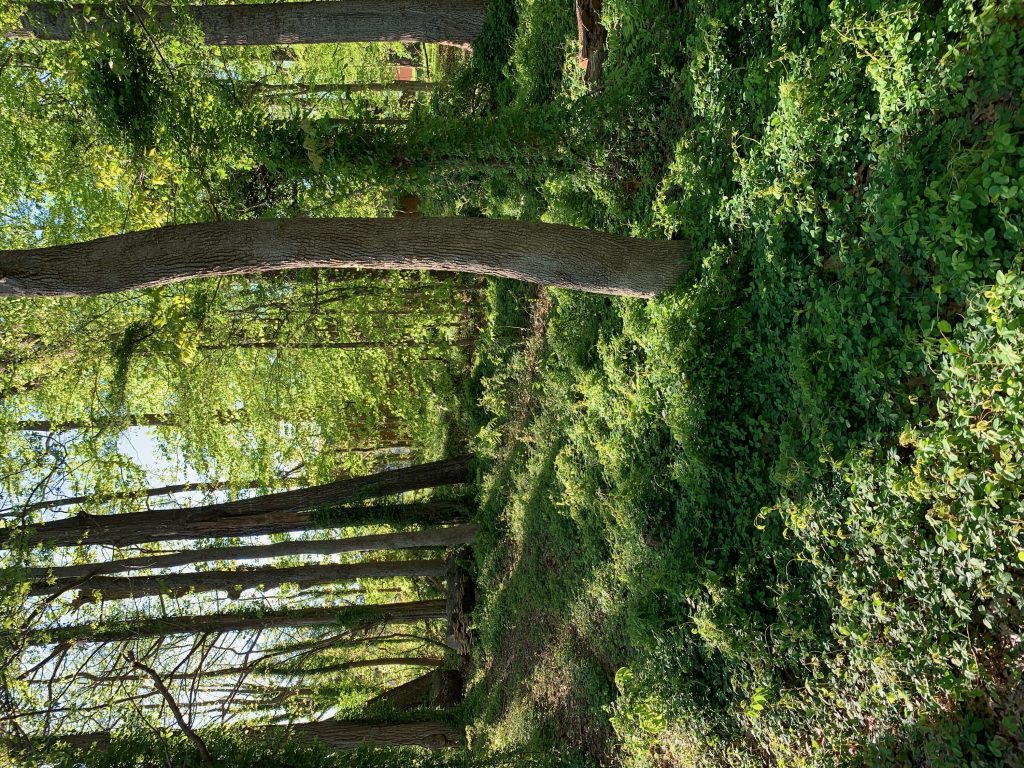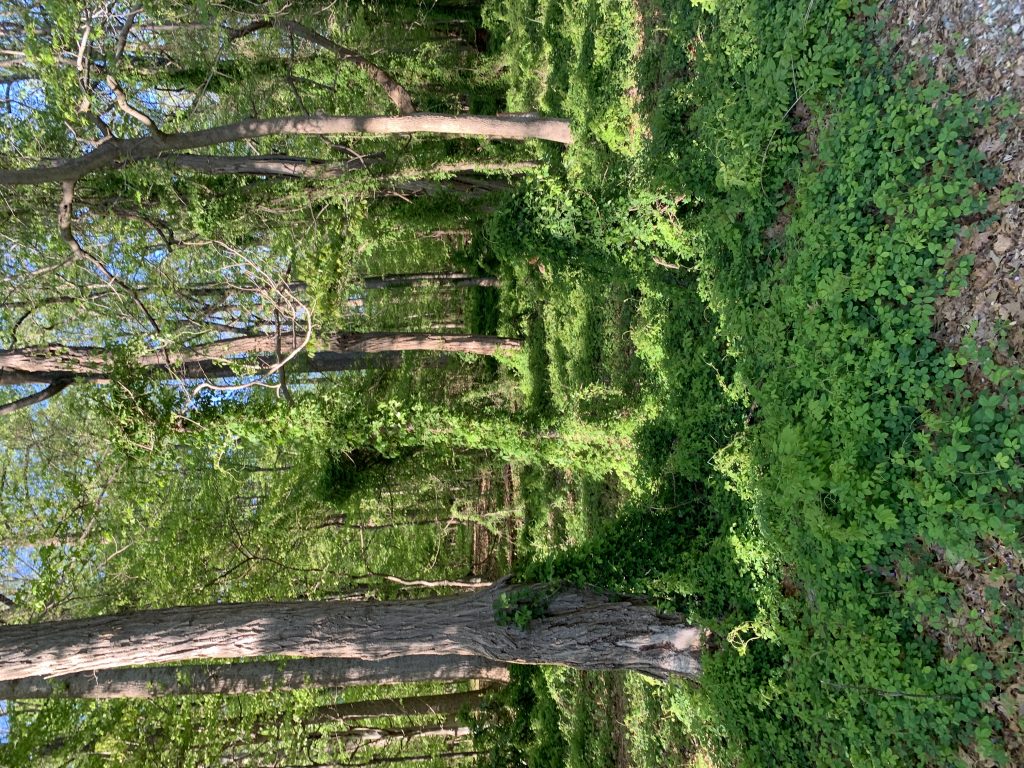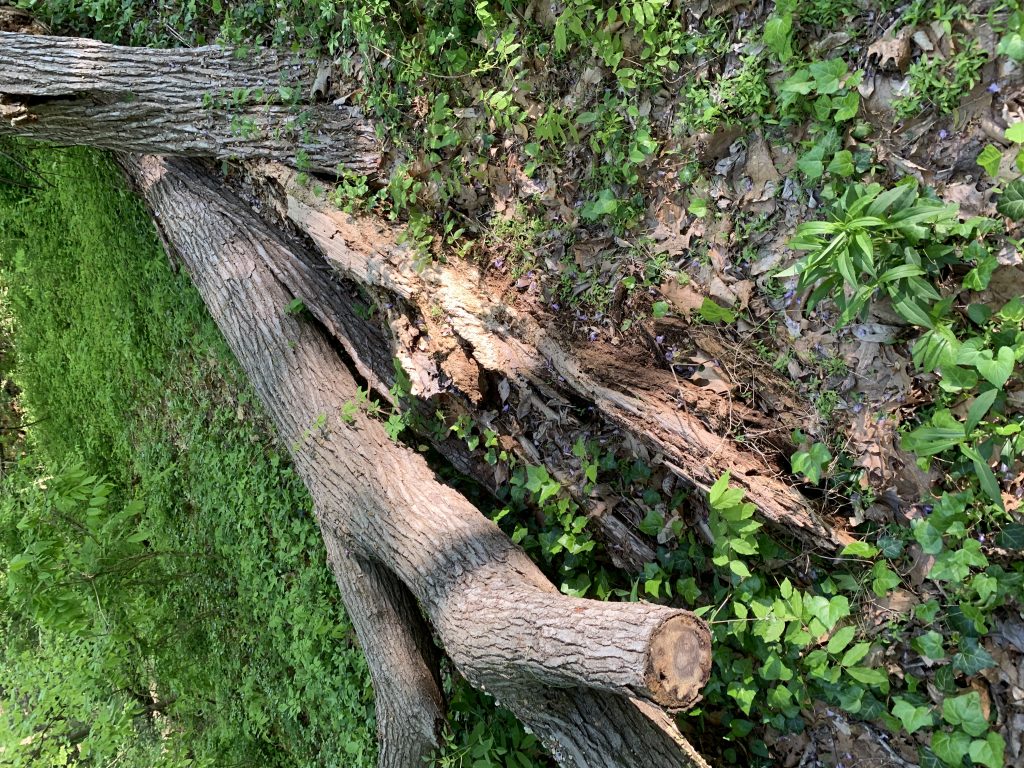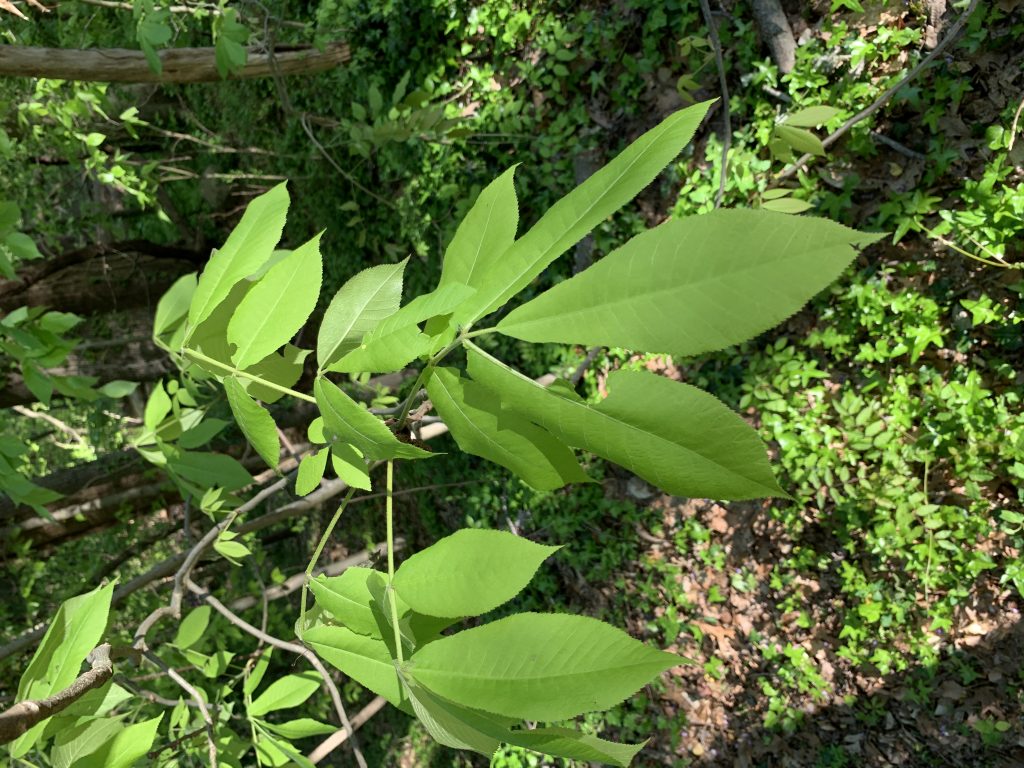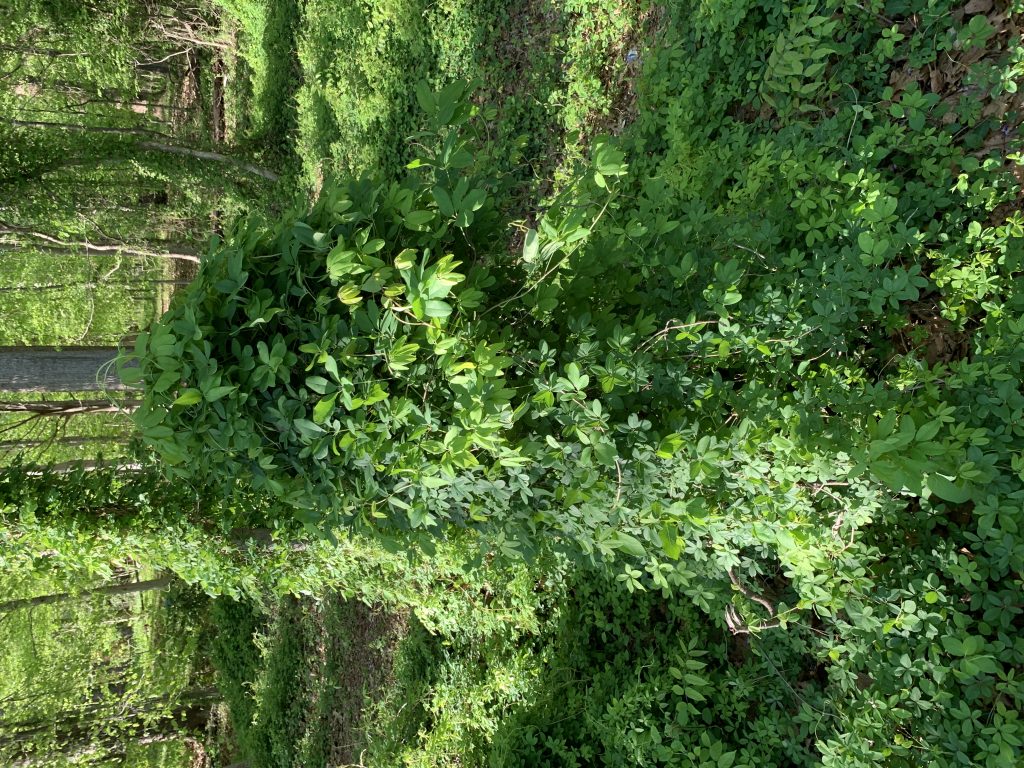The wind is blowing the branches on the trees gracefully. The mix from the past rainstorms and heat from the sun currently has created my perception of the perfect temperature. I feel the air blow through my hair going to the skin on my scalp. The presence of nature isn’t something I have to seek now; I can indulge in this warm invitation anytime I feel selfish enough to do so. Evidence of my past separation of nature is clear, but I no longer feel like the past is held against me. In nature, I feel free. Freedom is priceless, no amount of money will buy you this. I reached deep in my soul like I was a kid digging in his mom’s purse for a quarter for the toy machine. I feel the difference now from being outside and inside before that wasn’t so evident. The difficulties in my life I’ve handled with grace; I place them in my hands, and I delicately put them away. I don’t believe any amount of harshness will fix your problems, your real problems. In the future, from this moment, any motor speech difficulty or unpredictable blood level test will be handled gracefully. Nature has taught me not to be so harsh. Life is harsh, granite, but I and nature don’t have to match life. I don’t believe anyway I’ll wake up and say, “I conquered it all, I’m happy. I’m cured” what I struggle with will carry with me throughout my life. While I carry this weight with me like pounds and pounds of rocks in my bookbag, I can tell you I am a survivor, even if I stumble over a word. My words are valuable. I fought for the voice I have now.
Posts
Stained
The branches on the trees are barely shaking. The weather is windy but warm, and the
When I am in my place, my thoughts run loose but they seem not to race as much. I get to thinking about the past and what ways I can reconnect with nature. For me, making that connection is taking the power back; this is like saying, my health doesn’t own me. My health status doesn’t define me. My speech disorder doesn’t take away so many multiple ways I can use my voice. I use to almost stained by it. It’s like when you spill wine on a white tee shirt and try for hours to get it off. You are there scrubbing, desperately taking your soap and sponge feeling your muscles clench as the minutes go by. You feel the heat to at the temples of your head and sweat starts to reach the surface of your skin. After a while, you start to lose your breath. After a while of trying to remove the stain, and you realize you cannot, and you accept you can’t remove the stain. My voice is owning my truth and accepting it. It’s this alternative form of confidence for me. I use to be so ashamed of my struggles, why didn’t others struggle with speaking? Why did I have to be born with this? However, I have learned to be a voice and not a victim. I will never be a victim. I refuse it.
Unstable like the Weather
Unstable. A word that reflects prone to change or
Stable. A word that indicates in the medical community that a person isn’t deteriorating. A word I have been hearing within the past few years. While this status doesn’t mean I am recovered nor healthy, it can be a relief. While levels fluctuate and the future remains unpredictable, I can keep in mind the weather in nature changes in status too.
In my place a week ago, it was snowing in April. I saw the small snowflakes fall while my mind was in shock. The next week, it was eighty degrees and I felt the sun beating on my skin like a tattoo needle. Crazy, right? I keep in mind nothing stays the same. We never know what is coming next. We can’t predict the rest of the day, tomorrow, and the years to come. We only know what is in this moment. Time stays still but our thoughts race like the wind like hurricane weather.
I hear the wind in my ears. The flowers and scenery in my place, The Guilford Woods, is expanding like my sense of knowledge about nature. Nature is filling in the parts of myself that weren’t always secure. I have felt like in past not being so secure with my health and myself, that I wished my body I could cleanse with holy water; maybe if I dived into it that would save me. I’ve found now since diving into nature, if holy water touched my skin now it wouldn’t sink into the pores my skin. Nature has comforted me to make me realize I don’t need saving from someone else. Nature can take put myself back in my body and help me accept me for who I am. I’ve looked for the person I am today for the past twenty-one years. It was like I was desperately looking for a savior. I’ve came to realize I can only save myself.
Wrapped in the Leaves
Tap tap tap. I hear these few sounds from the gate in Guilford Woods that refuses to be anything but silent. I closed the gate to preserve my sanity. The gate is something that was
Connecting with my place is something that is vital in order to become one with nature. I do this by reflecting on my past struggles and finding
Green is the Warmest Color
Green is the warmest color that reflects off the irises of my eyes as I stare out over the Rancocas Creek running through the soft Pinelands of Camp Dark Waters. As I scan my eyes across the creek, they run vertically down the green shrubs and stop perpendicular to the mossy seafoam green covered ground. Green is the color of the earth, it provides and protects us from elements we cannot see. I spot a green endemic Pine Barrens tree frog sunbathing on a dried up stone on the opposite bank than me. The size of the frog is small enough to fit in my hand, as I image touching its leathery slimy skin. Slowly, I lean back to start up at the daily sunlight raining down on my black hair. As I touch my hair to put it up in a bun, I quickly pull away my hand because the blackness of my hair had absorbed some much heat. Staring up at the baby blue sky, my vision goes blurry for a second, trying to adjust to the extreme light exposure. I notice the edges of green canopies of the trees lining the bank of the creek, creepy into my peripheral vision. Closing my eyes, attentively listening to the chirping of birds echo in my eardrum, I begin to hum a song in my head. The song is “Blackbird” by The Beatles.

I think I drifted off into unconsciousness because the last thing I remember is humming Blackbird in my head. When I wake, I am greeted by the full bushy green canopies blowing in the wind towering above my head. I do not remember how long I have been asleep for, but my body feels at peace. My muscles feel like jello, vibrating inside my skin as I start to sit up. I get a head rush as I blink a few times to reorient myself on the bank of the creek. A run my hands and bare feet through the curly green moss. I’m unaware of the time because it feels like I was frozen in time dreaming until I woke up. Standing up, recognizing that my bones are weak and wobbly, I walk to the main area. The block hanging on the dining hall says 5:00. Dinner is going to be soon and then s’ mores. After dinner, I watch the sunset over the creek. The orange, yellow and red mix like watercolors in the reflection of the water. All the colors blur the line between the individual colors and they become one.

The blackness of the night surrounds me and my silhouette gets swallowed along with the watercolors. The moonlight overtakes the night sky as a few stars twinkle through the pitch dark blackness. I know that it’s time to go join everyone at the bonfire. I walk along in the darkness as though it’s my companion. The silence of the crickets keeps me motivated to put one foot in front of the other. I hear laughing and chatter as I get closer to the bonfire. I observe everyone’s smiling glowing faces from yellow light of the fire when I approach. I go to sit next to my friends. I grab a stick leaning against a rotting log. As I puncture the marshmallow with the stick and hold it over the fire. I noticed green veiny fungus rapping around the stick and is growing and thriving off the stick. I stare at the green fungus as though it’s the warmest color in the forest. The fire crackles in the background as the green mixes in with the fiery yellow watercolors create in my irises.

Personal Reflections Within a Space
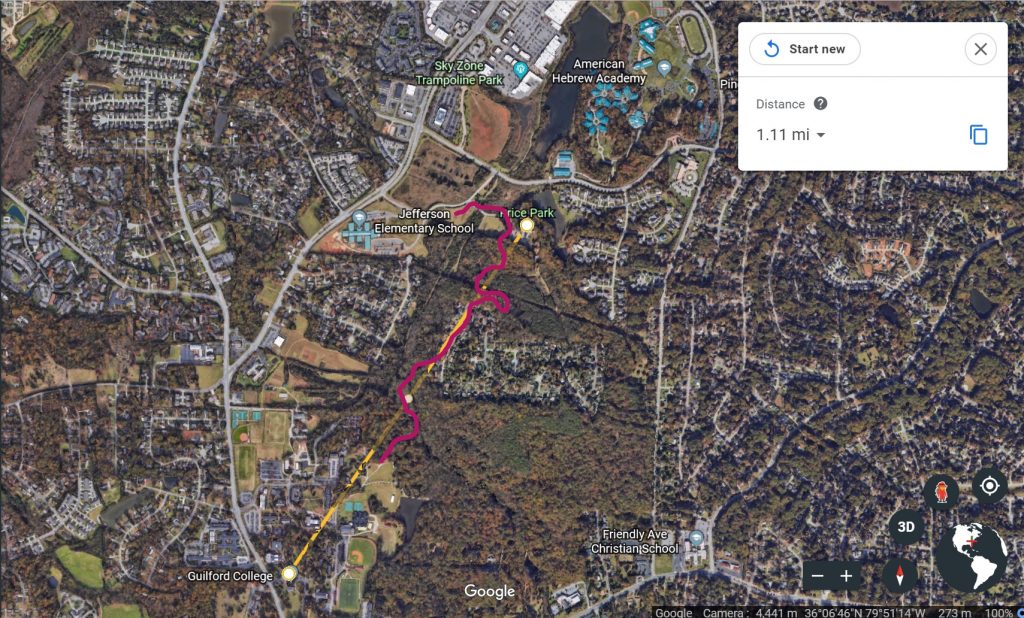
To get to Price Park, I typically walk through the Guilford College woods, a small neighborhood outside of these woods, and then into the pine forest of Price Park. I choose this walk, rather than driving from my apartment to the park, for a number of reasons. For one, I love the Guilford woods, and enjoy taking advantage of every opportunity I have to visit them, as almost every time I see groups of white-tailed deer, who always surprise me by how unafraid they are to approach me. Another reason is that every time I take this walk, with Price Park as my destination, the amount of time it takes to get to the park seems shorter and shorter. I’m not sure why this is — maybe my muscles have gotten used to the curves of the path, and even walking, or maybe time just goes by faster as I get increasingly comfortable within and aware of the space around me. Finally, and most importantly to me, it is because each time I arrive at the park, through an opening in a fence which takes me to the back edge (opposite Hobbs Road) of the space, I am able to choose between four different trails, which often each take me on a new route.
As I have said in a previous post, one of the things I love so much about Price Park, is that, despite it only being 98 acres in size, I never fail to discover something new about it. There are many paths, some manicured and meant to be there, and some less-often traveled, made by those who choose to stray from the trails. With this plethora of walking options, I am able to switch it up just about every time I go there — making it a never tiring, always exciting, new walk. One of my favorite things is to go off the purposeful trails — one can wander through the dry woods for what seems like forever, walking around fallen trees and between living ones which spurt almost no growth at human-height, and become unaware of the other people also at the park (as people don’t often go off the trail). However, if you walk long enough, you always get spit back out to a commonly-populated area. As I continue to visit the park I become increasingly familiar with where certain trees, posts, trails, etc. are located, and no matter how far I feel like I have strayed within the newly discovered (by me) territories, once I am released to the developed areas, I know exactly where I am and where I have been, and am able to find my way back home.
Price Park is perhaps the only space that I have grown so familiar with, and it is a wonderful feeling. It is strange though, that despite all the time I have spent outdoors throughout my life, I have never felt so close to a single space as I do with Price Park — a place that I have only been visiting regularly for a short amount of time. I know that this is only because of this assignment and this class, American Nature Writing, but it is a feeling and an experience that I don’t want to lose. At the same time, it is both odd and exciting to know that no matter how much I think I know about the space, what inhabits it, where things are, etc., there is an infinite amount left for me to discover. I have a feeling that no matter how many times I revisit, re-research, and re-experience Price Park, I will always have the urge to return and do it all again.
The Land
Let’s recap on some of the history of Country Park. In 1781, a war broke out against colonies in North America; a war more famously known as the Revolutionary War. One of the most significant battles of the Revolutionary War occurred right here in Greensboro, specifically at Guilford Courthouse (approximately an 8-minute drive from Country Park). At Guilford Courthouse, the British managed to gain a tactical victory over the American troops; however, the British also lost many members of their army at this specific battle. To preserve the prestigious piece of land in which the battle was fought upon, the Guilford Battleground Company purchased and adopted the land to be used as a national military park. The land that the company had acquired was a total of 125 acres. They made the decision to split this land into different pieces and represent them differently to the public. From the 125 acres obtained, a large portion was given to be used as a natural park. In 1924, the name “Country Park” was introduced. Just ten years later, on the Independence Day of 1934, Country Park had its official opening. As soon as it opened, Mayor Paul Lindley insisted that work must be done to the park so that it could act as a tourist destination. Immediately, funds and assistance flowed from the Civil Works Administration to “beautify” the natural piece of land. The Federal Works Administration also aided in making the natural space vast and beautiful. Now, Country Park is located within the Battleground Parks District, which also contains the Greensboro Science Center, Guilford Courthouse National Military Park, and Forest Lawn Cemetery.
What Happened With the Land in that Century?
As soon as the war was over, the land stood there still, no human had touched or modified it. Trees were blooming in the woods, as well as deers and squirrels were relaxing in their homes. I learned in my APUSH class last year that during those years North Carolina was known for having large pieces of open, vast land. Eventually, people began to trade and purchase pieces of the land that comprised the, now, Battleground Parks District. It began when John Hamilton took possession of the land but later sold the land tract to William Reed in 1794. Then Reed sold it to Smith Moor in 1797, then Moore sold it to John Moore in 1798, then to Robert Lindsay in 1804. In 1828, the land was split and distributed to many people to begin renovations to “preserve the legacy.” They used trees to make the boundaries, for example, a beech tree marking the southwest corner of the land tract. Eventually in the mid-1880s after exchanges of the land and plans the land was given to Paul Lindsay who had the option to decide how he wanted to represent it, which he decided to make it a family-friendly park. Paul Lindsay left some of the nature to thrive and grow on its own; however, he added many human-made features to catch the eye of many visitors in the future.
I hope you guys enjoyed a glimpse into the history of the land comprising Country Park. Obviously, you can see that the land was just purchased and sold for most of the years, but during that time the land was left to be preserved and away from the public, with the hopes of keeping the legacy and essence of what the land is famous for. See you guys later!
Jefferson Pilot Clubhouse & Destruction of a Natural Space
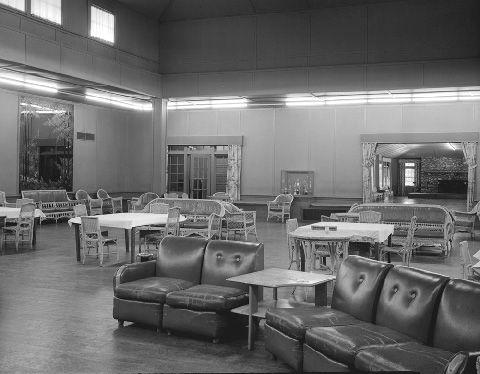
In 1928, still before Price Park was “Price Park”, a chunk of the mature pine forest was torn down. In its place, a building called the Jefferson Pilot Clubhouse was put up. This structure served as a retreat space (hence the name clubhouse) for the employees of the Jefferson Standard Life Insurance Company. Given the time, post Industrial Revolution, it is not surprising that such a mass of natural land was destroyed for the sake of humans. Per modern human tradition, people wanted a space “within the natural world” to retreat, get closer to one another, etc. Of course, they were not actually retreating within the natural world, but rather next to it. They could see it, but not experience it.
Unlike any of the previous human history known about Price Park, these people were not encountering the land in any way, shape, or form. They would likely drive to the space in their cars, go into the building, maybe walk around in the forests every now in then, but ultimately always return to the clubhouse, or their cars, or some other human constructed space. It is a strange thing to think about wanting to retreat in nature, yet at such a distance that you cannot learn about it or experience it. From within a building you are purposely distancing yourself from everything I would associate with the best parts of the natural world. I doubt these retreaters could hear many birdsongs from behind walls, or see much wildlife beyond the windows. They may have had a general knowledge of which trees were which, what flowers were what, and what animal or bird species they may or may not have seen, but I wonder how far this knowledge extended.
For employees of a life insurance company, I am curious to know how their knowledge of the natural world’s life compared to that of human life. Modern medicine had been far advanced since the times of the Revolutionary War and the Underground Railroad, meaning an understanding of medicinal plants was more just a hobby than pertinent information. The ability to get in a car, turn the key, and leave in case of an emergency also shuts down this desire to learn. Of course modern medicine is a good thing, and quick transportation is convenient, but at what cost? Price Park is such a beautiful space of land, with so much complex life within it, that it seems a shame to dismiss it or demean it to a “retreat” — a word that implies connecting with humans and not with the natural world.
The choice to put their building in place of a pine forest goes to show how careless they were. Of course it would have been peaceful to have a manicured space away from constant traffic and other development, but did these people stop to think about the fact that they created what they were trying to escape (a growing industrialized area)? It seems that those who work together likely know enough about each other to not have to go to the clubhouse to mingle — why not have a dinner party or an office gathering every now and then, in a space that has already been built, rather than going through all the time and money to tear down a beautiful and historical chunk of forestry? Why not go to the forest and mingle with the natural elements, rather than with people you see at least five out of the seven days a week.
It is frustrating to me that such a nice space of land was tarnished and destroyed for such a trivial structure. What habitats were destroyed in the process, and what respects were paid to make up for this? Probably many, and none. While it is frustrating, however, it is not in the least surprising. If this hadn’t happened in 1928, it would be sure to have happened later on, given that the land was unprotected and ultimately fair game.
Triad Park: Spring is Setting (Here Comes Summer)
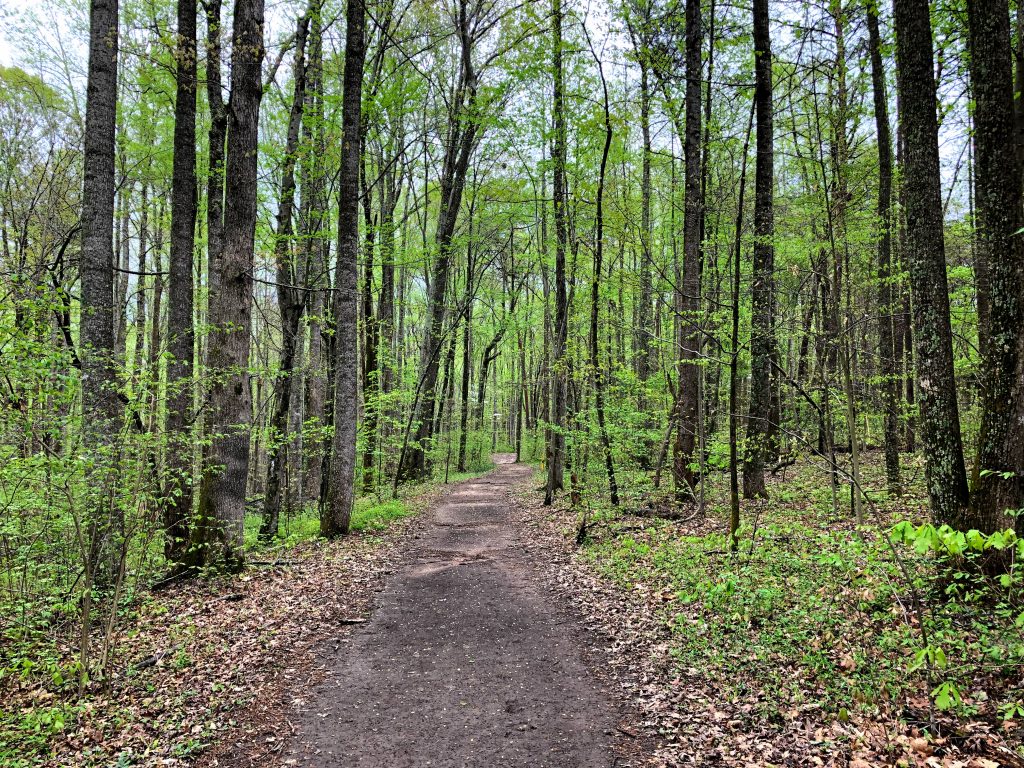
Every year, one of the best treats nature gives us is the sprouting of the vegetation that has been dormant all Winter. At first, it creeps up, coming out like a sluggish student out of bed at 8:30 AM. But once it gets some “coffee” in it, it flourishes with life and purpose. Well, I think the trees have had their coffee. What started as a slow crawl has become a canter. When this begins to happen, I reflect on everything that I love about the park. I’ve been going there since I was a kid, and soon I will be a senior at Guilford College. Time is a weird phenomenon. But as the woods convey, time is nothing but a cycle; it pushes things along until they reach their end, and then new life appears and the process starts again (hey, I’m not being pessimistic here–it’s actually quite beautiful!). As I contemplate all of the memories that are within the gates of the park, a few human-animals come to mind, one of which is among my favorites.

The animal pictured above is sometimes referred to as an “Alee.” However, after hours of contemplation, I came to the conclusion that she is a human female. Humans, also referred to as Homo sapiens by science, are actually (the only) members of the subtribe Hominina. We are unfortunately an invasive species. Humans tend to take everything for themselves and only give to things outside of their human-realm if it is convenient for them to do so. Alee must be a mutation though, because she is actually pretty awesome. We seem to be

Wildflowers are the second factor that keeps me coming to the park, other than the park’s variety of trees. The ones pictured above makes everything around them glow purple; it was truly a magical moment. Whether its common blue violets or dogwood trees, Triad Park is rich in floral. Once Autumn arrives, the normally green leaves transition to different colors, making leaves almost appear like flowers in the treetops.
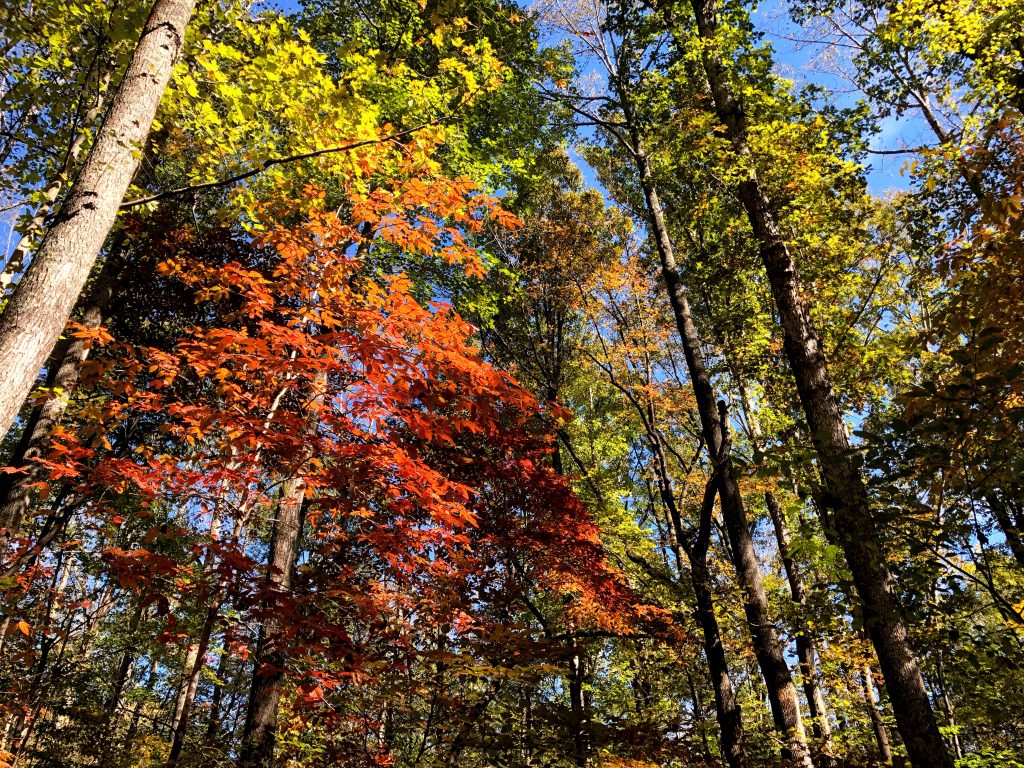
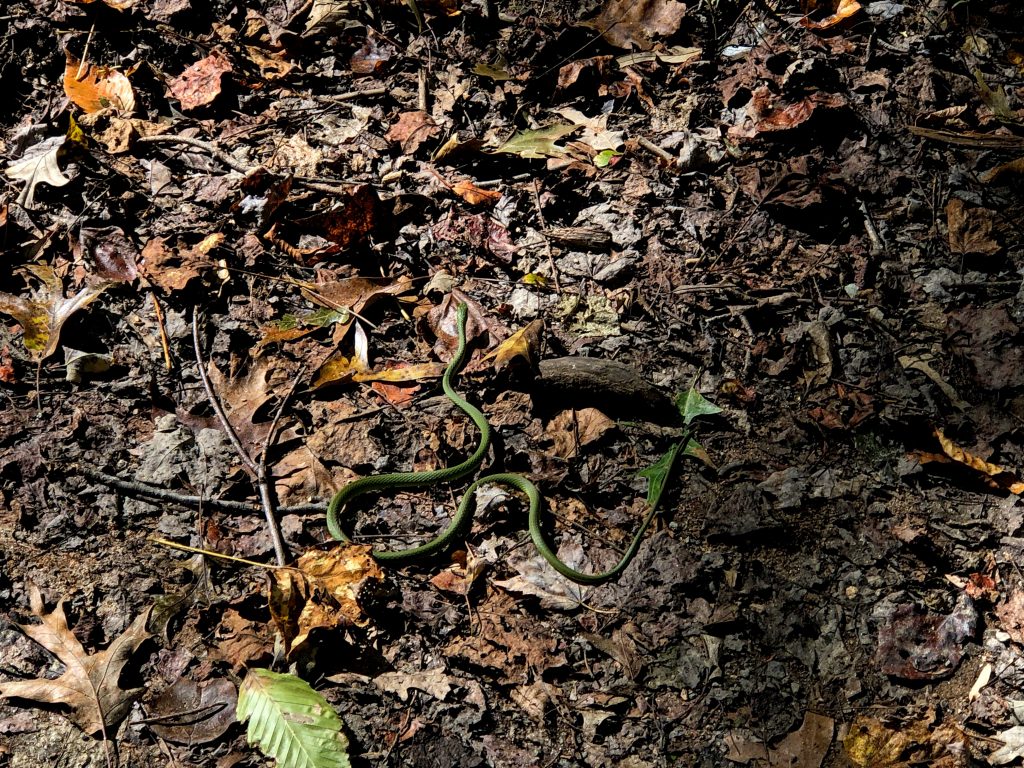
The Autumn colors seem to bring out life, much like Spring; for example, I encountered a rough green snake while hiking last October. The colors were peaking, and the snakes were peeking before hunkering down for the chill of Winter. Every season brings its own magic to the forest; Summer brings intense yellow and the Wood thrush, among other awesome migratory birds. Fall paints the forest in oranges, reds, and yellows. Winter chills the air and erases the harsh humidity of the Summer, and sometimes lays a white blanket of snow over the trail. The snow melts in Spring and the green comes back out to play, along with many human and non-human animals.
Never Enough Trees
In my opinion, the largest part of nature are the trees and many plants you witness around you. So, today I have stopped by to talk about a few more trees I found in Country Park.

Photo taken by me
The white flowering dogwood was located deep within the biking trail throughout Country Park. When I first noticed the dogwood, I was slightly confused because the branches were shrill and thin and there were very little white flowers blooming. Around Guilford College campus, I notice a few dogwoods here and there, and I remember David Petri pointing some out during our nature walk. However, this was different from any other dogwood I had ever seen which made it very special. I have been down these trails so many time but have not paid as much attention to the natural beauty around me until I began to write these blog posts. The sun hit the tree perfectly at this time of day, presenting it as the perfect place to sit near and study, read, or relax and listen to music. I walked up closer to observe this flowering tree and noticed a bee pollinating one of the flowers in the tree. With my fear of bees, I quickly scurried away, but I knew in the back of my mind I would come back to this spot again in the future.
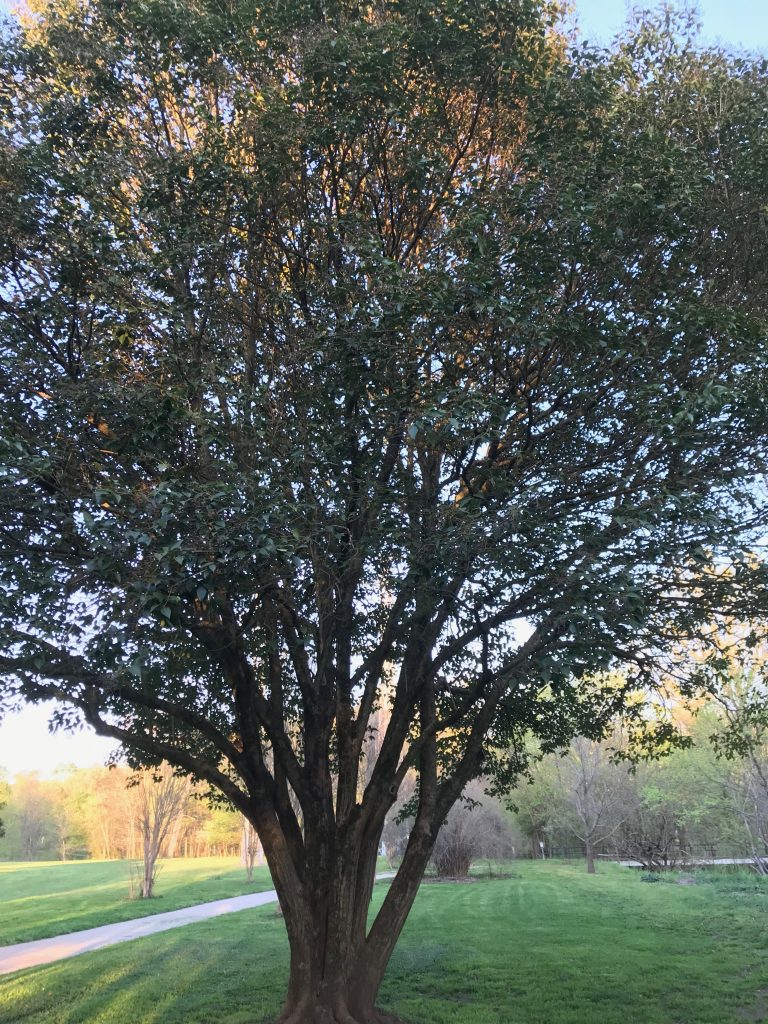
Photo taken by me
The next tree I saw was an oak tree. Oak trees are very common to the southeastern United States, and you all are probably used to seeing so many of these all over Greensboro. What stuck out to me about this particular tree is how it is located in a bunch of emptiness and amidst a bunch of sidewalks taking away from its natural essence. Along with that, I saw a few squirrels run up the trunk of the tree into the leaves of trees, from an outsiders point of view, making them seem like they got lost within all the leaves and branches of the oak. I think about how people running around on these sidewalks and screaming can disturb the squirrel’s silent homes. Trees within the forest have such a loud silence that any slight noise bounces away. This oak tree presents itself as a decoration for the park, rather than a home and valuable addition to natural creatures and the rest of the natural world.
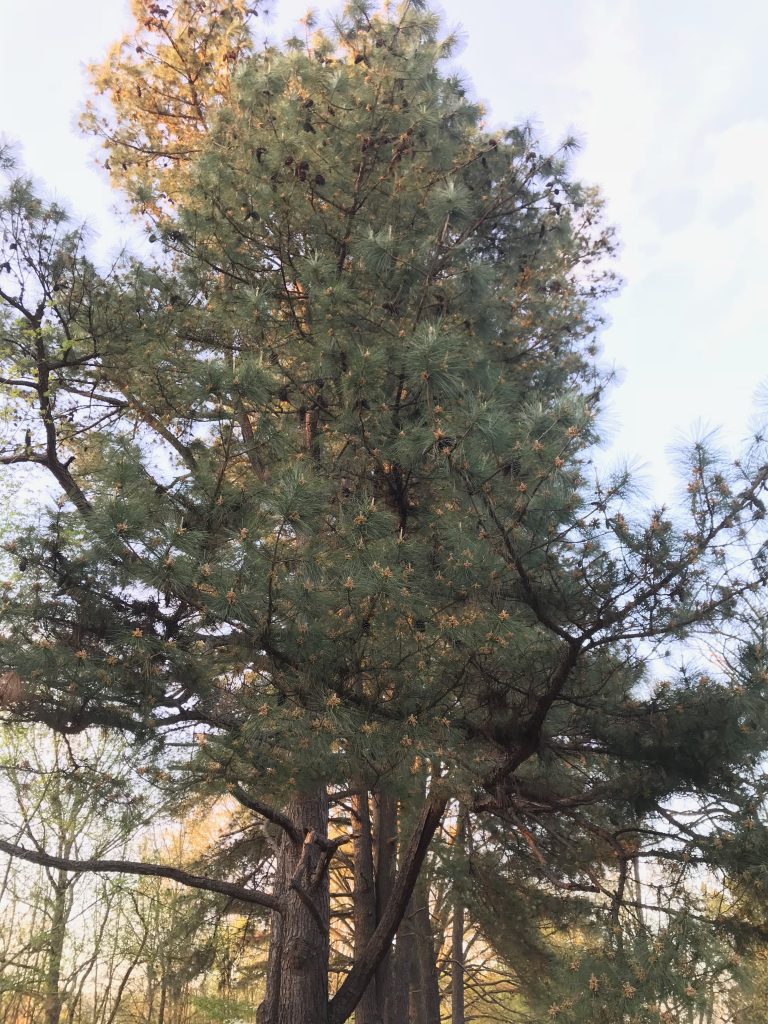
Photo taken by me
This last tree is a conifer pine tree. I was very fascinated by the blur effect the leaves and conifers the trees produced. This was like art. Most of the pine trees I had seen in Country Park were Loblolly pine trees; however, witnessing a different type was an amazing change to the usual. The bark was spiny and bumpy, which gave it a satisfying feeling. Also, the tree was surrounded by many pine cones, which made sense since it is a pine tree. In a previous post, I focused on these conifers and the pines cones that this tree also produced.
Thank you for stopping by today. I look forward to bring you more memories from Country Park!
